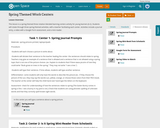
A short video explaining the seasons and how nature changes within the year. Video also discusses how we change to adapt to the different seasons. [3:00]
- Subject:
- Science
- Material Type:
- Audio/Video
- Provider:
- PBS LearningMedia
- Date Added:
- 12/01/2022

A short video explaining the seasons and how nature changes within the year. Video also discusses how we change to adapt to the different seasons. [3:00]

Discover the seasons together with the ancient Greek philosopher Plato. Did you know it is summer on Atlantis when it is winter in Australia?

Students will use weather data they collect to predict future weather. Included in this lesson are a weather forecasting recording sheet and an example of a student's completed work.

How does air affect our weather? Students will conduct an experiment to demonstrate how air pressure and humidity work. Included are pictures and videos of the lesson in action, whole group and individualized instruction plans, and a wrap-up idea.

Students will be able to identify and learn about clouds.

What objects are in the day sky and the night sky? How do they seem to move? Come and explore with us as we discover the sun, moon, planets and stars! This detailed lesson plan includes pictures and videos of the lesson in action, materials, a parent letter, and examples of student's work.

In this lesson students will build and learn how to use three weather. They will use these instruments to collect weather data over a period of two weeks.

In this Dinosaur Train Clip, students learn the importance of rain to all life cycles. [1:24]

In this Dinosaur Train clip, the Pteranodon family is going on a camping trip. The train conductor explains about day and night, the changes in temperature between them, and how the sun rises and sets because the Earth is rotating on its axis. [1:50]

The signs of global climate change are becoming more and more evident. The EPA provides an excellent guide for students that acquaints them with the basic causes, effects on people and the environment, and solutions that they can engage in. Here is an informative site that will prepare the student to make a difference.

Track tulip growth as the season changes from winter to spring. See how temperature, rainfall, and sunshine affect growth and help scientists look for patterns of climate change.

Here's an engaging activity to incorporate dance into your science lessons on weather! Students study wind, and various weather patterns, then create their own dance to illustrate what they have learned. Provides links to more information, and diagrams.

ZOOM guest Amy wants to be a meteorologist and volunteers at a weather observatory. In this adapted video segment, she shows us instruments used to predict the weather and describes how air pressure affects weather patterns. [1:27]

In this video, students learn a variety of fitness activities in which they depict the weather though movement. [10:38]

This simulation allows the user to see the sun's arc in the sky anywhere in the world at any time. By changing the season settings the user can see how seasons affect the height of the sun's arc.

This video segment produced for Teachers' Domain features a time-lapse video of clouds forming, changing, and moving across the sky.

In this video segment produced for Teachers' Domain, observe different types of precipitation, including rain, hail, and snow. [1:00]

This lesson is a spring themed three rotation blended learning centers activity for young learners (k-2). Students will rotate through three spring themed activities, with a teacher facilitating each center. Activities include a journal entry, a video with a Google Form assessment, and a mini-reader.

Why do some regions experience full-time heat while others are reckoning with frigid temperatures and snow? And why are the seasons reversed in the two hemispheres? Rebecca Kaplan explains how the shape of the Earth's orbit around the Sun and the Earth's tilt on its axis affect the amount of sunlight each region receives.

This interactive site allows students to describe their local weather using various weather related graphics. Students summarize the local conditions by typing a brief description using a list of weather related vocabulary words.